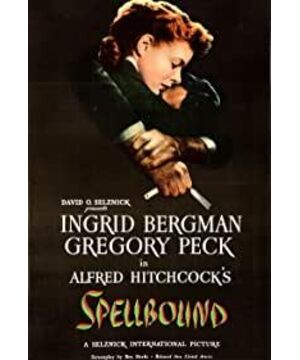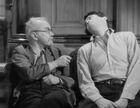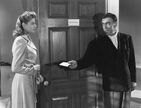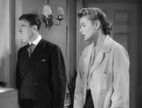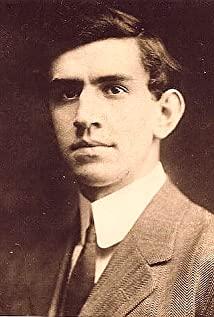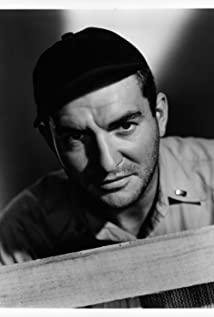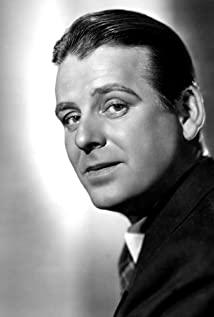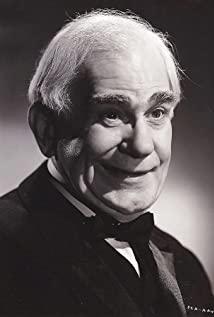The huge oil painting "Lost and Lost" (5.2 meters high and 11.5 meters wide) in the exhibition hall was created by Dali for the film "Doctor Edward" directed by Hitchcock. This film connects the three masters of Freud, Dali and Hitchcock together, and unfolds a series of wonderful psychological analysis with surrealist dreams, which is unique.
In 1899, the founding work of psychoanalysis "Analysis of Dreams" came out. The Austrian Freud created a new field of psychoanalysis and subconscious research, marking a new era of modern medicine. At the same time, his research results have also profoundly affected many fields such as film and painting.
"Doctor Edward" directed by Hitchcock in 1944 was the first film on the theme of psychoanalysis in film history. This film is still outstanding even if it is judged by today's standards. "Love" was filmed in 1944, but it was officially released a year later. It is said that Hitchcock hoped to put a surrealist dream in the film. He has been waiting for the Spanish Dali to complete this initiative.
Dali is one of the representatives of the Surrealist painting school. He created the "self-induced paranoid state method", which is to simulate dreams in a waking state, and then use this as the material to create weird Anti-realistic visual effects. Therefore, Dali’s works are often photo-realistic but absurd and illogical. He has a famous saying: "I don't do drugs. I am drugs. (I never take drugs, because I am a drug)"!
The film tells that the old dean of the mental hospital is about to retire. He is replaced by Dr. Edward, played by Gregory Parker, and the female doctor played by Ingrid Bergman fell in love with him at first sight, but she found this person in the process of getting along. He is not the real Doctor Edward, all indications indicate that he may also be the murderer of Edward. But the female doctor firmly believed that she was not the murderer, so she carried out a series of wonderful psychological analysis using psychoanalysis, and finally discovered the truth.
The psychoanalysis of this film is based on several dreams jointly designed by Hitchcock and Dali. In the surrealist dreams, the characters and scenes almost form a one-to-one mapping relationship with reality. From today's perspective, this mapping relationship is too neat and lacks skills, but it can be said to be unprecedented in that era.
Regarding the subconscious, Freud has a metaphor: people are like icebergs. People seen in reality are only the tops of the mountains exposed to the surface of the water, and a larger part of the subconscious is hidden under the water, which contains instinctive desires and traumas. But they are all suppressed by our customs and reason, and only indirectly revealed in dreams or when we are crazy. In the film, Gregorian recalled his dreams one by one for the female doctor to record and analyze.
The film has a processing flaw: Gregorian recalls the details of the dream almost in a waking state, and we all know that the dream itself is difficult to reproduce and recall. Of course, hypnosis is added in most subsequent movies to justify it.
The Gregorian in the dream appeared in a place full of eyeballs (the source of the creation of the oil painting "Lost and Emotional"). Dali has three treasures: eyes, lips, and clocks are still soft. Among them, the eyes are surreal visual symbols in Dali's works. The shape of a single eyeball with wide eyelashes is a mixture of Dali's own eyes and beard. Eyes all over the air are watching everyone in the scene. A man is cutting the curtains and a woman is kissing everyone in the arena. From this, Ingrid Bergman judges that these two unreasonable behaviors are neurotic patients, and the eyes represent the nursing staff of the neuropathy. The place corresponds to the mental hospital in reality.
If you look closely, you will find that the legs of the tables and chairs in the scene are women's legs wearing high heels. This weird design suggests that this place may also be a sensual place. Combining with the blackjack poker picture that appears later, it can be inferred This is a club called Blackjack in New York. Together with the mental hospital analyzed above, it constitutes the superposition of the two scenes in reality in the dream. The inspiration for the high-heeled armchair in the film was later used by Da in the furniture design, known as the Leida chair. As well as the Leida chair is the red-lip sofa designed by Dali inspired by Hollywood actress May West.
The beard is Dali’s own iconic feature, he used it in the film, the man with the beard playing cards is Edward, and his opponent is Gregorian. At this time, the casino manager with his face covered, he thought Edward had cheated and threatened severe punishment for the next offence. Based on previous observations, it can be preliminarily determined that the casino manager is the dean of the mental hospital. He was replaced by Edward because of his dissatisfaction and threatened the latter.
In the next dream, Gregorian and Edward stood on a roof, and then Edward fell. Suddenly, the masked casino manager came out from behind the chimney with a twisted wheel and threw the wheel on the roof. Then Gregory was chased by a pair of big wings and ran down the mountain, waking up from his dream. The twisted wheel is a common element in Dali's paintings. In the film, the wheel represents the pistol, and the large wings symbolize the angel. The corresponding scene is the Angel Valley.
Combining these factors, Ingrid Bergman concluded: At the Blackjack Club, Edward ignored the dean’s warning and was assassinated when he and Gregory went to the Angel Valley ski resort together. The dean fired a shot at Edward's back, and then dropped the pistol in the snow. And Gregory, because of the shadow of his childhood and the double stimulation of witnessing Edward's murder, subconsciously mistakenly regarded himself as a murderer. At this point, the truth is finally revealed.
The film won a double harvest in the box office and word-of-mouth in the year it was released, and won the third largest box office in the United States with 47 million U.S. dollars. This story of chasing a fugitive was more mysterious and unpredictable because it was dressed in a psychoanalytic cloak, and it had a profound impact on later psychoanalytic films.
The whole film of "Doctor Edward" was created around Freud's theory, and Freud died in 1939, he did not wait for the release of this landmark film.
【Finish】
—————————————————————
The birth of the camera put the classicist painting in a predicament, and painters have found new ways. Modern painting has turned from "perception of nature" to "exploring the heart".
In the mass disturbances of the twentieth century, Picasso moved towards Cubism. He disrupted and rearranged the familiar object structure in reality to make it visually untenable but emotionally established; Kandinsky created abstractionism. He paints with different colors and geometric shapes, without a main image, but gives people a visual and spiritual impact beyond the concrete. Their works have abandoned the imitation of the real world and the entanglement of "likeness and dislikeness".
And Dali’s prescription is “precise counter-reality”, that is, using Freud’s theory and a large number of psychological elements to construct dreams, and using photography-like clear and realistic style to strengthen dreams, so that they are intertwined with reality. Conflicts are difficult to distinguish. In this sense, although Dali did not convert to Freud, his works are one of the best carriers of Freud's theory.
View more about Spellbound reviews


